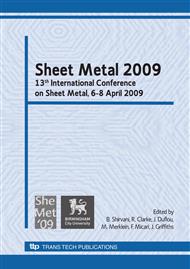p.289
p.297
p.305
p.315
p.325
p.335
p.347
p.355
p.365
Investigations on Three-Roll Bending of Plain Tubular Components
Abstract:
Bent metal tubes find a widespread application in many industrial sectors. Among different bending processes developed for the manufacturing of these components, three-roll bending is characterized by a high flexibility, as only one toolkit per tube diameter is necessary to form the required bending radius. In this type of forming process the part geometry is obtained by means of a relative movement of the die (setting roll) towards the fixed tools (bending and holding roll) with simultaneous feeding of the tube. This study describes the FE-model developed for the three-roll bending and presents first results of numerical investigations conducted on steel tubes made of carbon steel St37. By the FE-analysis great attention is paid on the modeling of the stiffness of the tool, on the description of the kinematics of the setting roll as well as on the characterization of the material behavior for the simulation. The results of the numerical investigations are compared with experiments conducted with a CNC-bending machine available at the Chair of Manufacturing Technology of the University of Erlangen. As a main criterion for the validation of the FE-model the radius of the tube at the extrados and the bending angle are chosen. The geometry of the part is measured by means of both optical and tactile measuring devices.
Info:
Periodical:
Pages:
325-334
Citation:
Online since:
March 2009
Authors:
Price:
Сopyright:
© 2009 Trans Tech Publications Ltd. All Rights Reserved
Share:
Citation:


